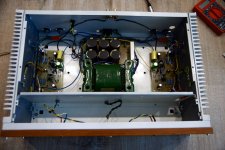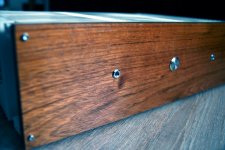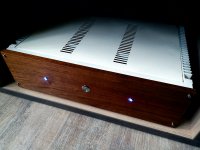ref. post661 , onsemi figure 9......estimated 10MHz for npn, around 12MHz for pnp type , i guess...........
Thanks, mjfref. post661 , onsemi figure 9......estimated 10MHz for npn, around 12MHz for pnp type , i guess...........

Can someone direct me to info on XFMR sizing? I know I've seen posts and I think NP has written some stuff also. Thanks
Class-AB? I'd think a VA equal to the amplifier's total output watts x2-4 would be a good rule of thumb.
That seems excessive? 1.5 - 2x total wattage should be sufficient for most purposes. If it's for use in a pro setting, or really going to be running hot all the time, you might go up.OK OK so your saying 800VA to 1.6kVA correct? It needs to be that big for an AB design?
Most of the time you can figure 50% efficiency at best, so a 100 watt/channel
for a given load might draw 200 watts. On top of that, you would might want
some margin (around here an added 100% it seems) for 400 watts.
Two channels? 800 watts.
But for music you can get away with a lot less.
For Class A, assume the worst - idle dissipation x 2 for each channel.
for a given load might draw 200 watts. On top of that, you would might want
some margin (around here an added 100% it seems) for 400 watts.
Two channels? 800 watts.
But for music you can get away with a lot less.
For Class A, assume the worst - idle dissipation x 2 for each channel.
What matching should be done with the TIP142 and TIP147 darlingtons?
(I don't have any experience with these parts.)
Thanks,
Dennis
(I don't have any experience with these parts.)
Thanks,
Dennis
I don't think they need matching - at least for MJ 11015/16 parallel transistors, there is no significant difference in the bias current between the individual transistors.
@Eugene L. - Singapore (I don't remember your nickname),
please send me a PM, your boards are back to me (incorrect / Insufficient shipping address)
@manniraj,
that lets hope!
Hi Carsten, I have PMed you. Not sure if you have sent them out again?
Thanks Osscar.
I'll probably order extra parts and try measuring them. If nothing else, that
should be educational. 🙂
Cheers,
Dennis
I'll probably order extra parts and try measuring them. If nothing else, that
should be educational. 🙂
Cheers,
Dennis
@yuujin,
did not send again. I wrote you a PM (few days ago) to send me your address again for verification but didn't received an answer ..... please send my your address and then I will send it again to you.
did not send again. I wrote you a PM (few days ago) to send me your address again for verification but didn't received an answer ..... please send my your address and then I will send it again to you.
Some time ago I got the LEDs I wanted, finally I am done with this amplifier 😀. Also, the output RCA replaced with the "long" type - a better ground contact than the cheap ones from ebay and they better secured through the back plate IMHO .
Attachments
now you can open a Movie Theater or something - it looks exactly as those industrial amps from Yore
maybe because it is the case of one 🙂
maybe because it is the case of one 🙂
Lower resistance = higher bias.according to D.Self higher RE value=lower bias optimum value.
Can someone expound on this please? I would have thought that it would always be higher bias.
Can someone expound on this please? I would have thought that it would always be higher bias.
Self has an optimum bias and Emitter resistance values for bipolar followers which
gives the lowest distortion number. Since it tends to be a fairly low current figure,
it has additional reason for some popularity.
This formula is limited to Bipolar devices in push-pull operation.
Pretty much nobody advocates lower bias or higher resistance values than these,
but some designers advocate higher bias and lower resistance.
gives the lowest distortion number. Since it tends to be a fairly low current figure,
it has additional reason for some popularity.
This formula is limited to Bipolar devices in push-pull operation.
Pretty much nobody advocates lower bias or higher resistance values than these,
but some designers advocate higher bias and lower resistance.
- Home
- Amplifiers
- Pass Labs
- AB100 Class AB Power Amplifier



